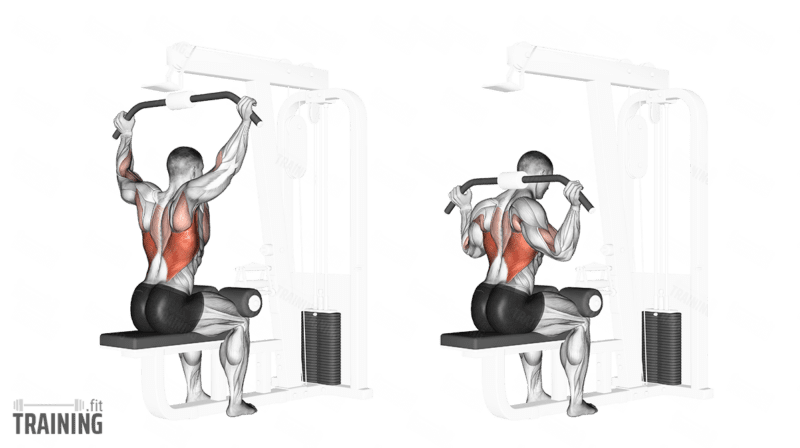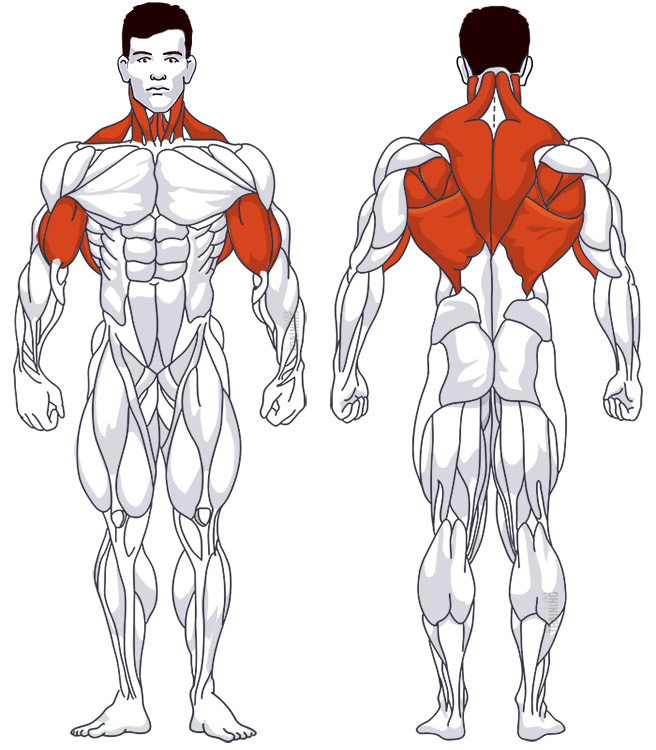Neck Lat Pulldown
Compound exercise, Cable pullThis article is verified by 2 studies/publications.
Overview

Main muscles
- Biceps: Arm flexor
(Musculus biceps brachii) - Upper arm: Coracobrachialis muscle
(Musculus coracobrachialis) - Neck: Trapezius muscle
(Musculus trapezius) - Back: Large round muscle
(Musculus teres major) - Back: Large back muscle
(Musculus latissimus dorsi) - Back: Larger rhomboid muscle
(Musculus rhomboideus major) - Back: Small round muscle
(Musculus teres minor)
Training plans
Neck Lat Pulldown is a suitable substitute for similar exercises in upper back training or as a supplement to various training plans.
Neck Lat Pulldown: Basics and alternatives

Involved main muscle groups:
Neck Lat Pulldown
The neck lat pulldown is a variation of the standard cable lat pulldown. The exercise is mostly the same: you sit on the bench and pull the lat bar down. However, instead of pulling it in front of your body, you guide it behind your head to your neck. Muscle activation is also largely the same.
However, the neck lat pulldown has a bad reputation. While it works the same muscle groups, the stress on the shoulder joints is higher due to the unnatural grip. The shoulder joints are turned outward and horizontally abducted, which can lead to injury and long-term issues, like anterior instability with further problems[1]. As a result, this exercise should generally be avoided and used only in rare exceptions.
However, it’s worth mentioning that not everyone agrees with this view. The risk of injury may also depend on the individual’s physique. People with good shoulder mobility are more likely to perform the exercise without problems[2]. As you progress in your training, you’ll need to figure out which group you belong to.
Other upper back exercises include the standard lat pulldown, lat pulldown on the machine, or pull-ups.
Correct execution
Given the potential problems associated with neck lat pulldowns, it’s crucial to choose a conservative training weight for this exercise, especially at first.
Video tutorial
Step-by-step instructions
Adjust the weight and stand in front of the bench.
Grab the lat bar with an overhand grip wider than shoulder width (at the angled handles) and sit with your arms extended toward the bar. As you do this, you’ll already be lifting the weight slightly. Secure your legs under the pads.
Slightly pull your shoulders back and create a gentle arch in your back. You’re now in the starting position.
Pull the lat bar down behind your head. Keep your elbows close to your body. To do this, focus on moving the weight towards your hips rather than behind your back. Only at the end of the pulling motion do your elbows move a bit behind your back. Hold this position for a brief moment.
Slowly and controlled, return the weight to the starting position.
Common mistakes and injuries
As mentioned earlier, pulling the bar behind the head is generally controversial. By bringing the handle to your neck, the stress on your shoulder joints increases significantly. It’s crucial to listen to your body during this exercise. If you feel pain in your shoulders, switch to a different exercise and don’t push through the discomfort.
A common mistake when performing neck lat pulldowns is swinging the upper body to gain momentum to move the training weight more easily. Avoid this at all costs, as it diminishes the desired training effect. Instead, you’re putting more stress on your joints through forced movements, which could worsen the already suboptimal shoulder joint stress.
Sources
- A Comparative Analysis and Technique of the Lat Pull-down. Snarr, Ronald MEd, CSCS*D; Eckert, Ryan M. BS, CSCS, CPT2; Abbott, Patricia PsyD. Strength & Conditioning Journal: October 2015 – Volume 37 – Issue 5 – p 21-25. doi: 10.1519/SSC.0000000000000173. URL: https://journals.lww.com/nsca-scj/Abstract/2015/10000/A_Comparative_Analysis_and_Technique_of_the_Lat.4.aspx, accessed 2020-09-13.
- Overhead shoulder press – In-front of the head or behind the head?. Mark R.McKean, Brendan J.Burkett. Journal of Sport and Health Science, Volume 4, Issue 3, September 2015, Pages 250-257. doi: doi.org/10.1016/j.jshs.2013.11.007. URL: https://www.sciencedirect.com/science/article/pii/S2095254614000106, accessed 2020-09-13.